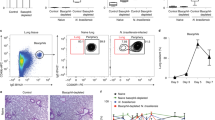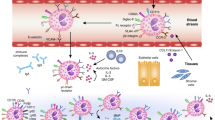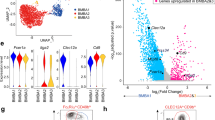Abstract
Basophils, the least abundant granulocytes, have poorly understood functions. They have been linked to the development of T helper type 2 immunity during parasite infection and allergic inflammation. Emerging evidence has not only shown the critical involvement of basophils in the development of T helper type 2 immunity but also provided useful animal models with which basophil functions can be further examined. However, distinctions must be made between what basophils 'can do' after in vitro manipulation and what they 'actually do' during in vivo immune responses; these may be very different. In this review, the functions of basophils determined on the basis of analysis of in vitro and in vivo systems and their potential involvement in clinical settings are discussed.
This is a preview of subscription content, access via your institution
Access options
Subscribe to this journal
Receive 12 print issues and online access
$209.00 per year
only $17.42 per issue
Buy this article
- Purchase on Springer Link
- Instant access to full article PDF
Prices may be subject to local taxes which are calculated during checkout



Similar content being viewed by others
References
Iwasaki, H. & Akashi, K. Myeloid lineage commitment from the hematopoietic stem cell. Immunity 26, 726–740 (2007).
Arinobu, Y. et al. Developmental checkpoints of the basophil/mast cell lineages in adult murine hematopoiesis. Proc. Natl. Acad. Sci. USA 102, 18105–18110 (2005).
Mitre, E. & Nutman, T.B. Basophils, basophilia and helminth infections. Chem. Immunol. Allergy 90, 141–156 (2006).
Min, B. & Paul, W.E. Basophils and type 2 immunity. Curr. Opin. Hematol. 15, 59–63 (2008).
Falcone, F.H., Zillikens, D. & Gibbs, B.F. The 21st century renaissance of the basophil? Current insights into its role in allergic responses and innate immunity. Exp. Dermatol. 15, 855–864 (2006).
Mukai, K. et al. Basophils play a critical role in the development of IgE-mediated chronic allergic inflammation independently of T cells and mast cells. Immunity 23, 191–202 (2005). An elegant study showing that basophils are critical mediators of chronic allergic inflammation.
Mack, M. et al. Identification of antigen-capturing cells as basophils. J. Immunol. 174, 735–741 (2005).
Min, B. et al. Basophils produce IL-4 and accumulate in tissues after infection with a Th2-inducing parasite. J. Exp. Med. 200, 507–517 (2004). The first study that identified mouse basophils as the main IL-4-producing cells during parasite infection.
Sokol, C.L., Barton, G.M., Farr, A.G. & Medzhitov, R. A mechanism for the initiation of allergen-induced T helper type 2 responses. Nat. Immunol. 9, 310–318 (2008). Study demonstrating basophil production of T H 2-inducing cytokines such as IL-4 and thymic stromal lymphopoietin and their involvement in in vivo T H 2 differentiation.
Denzel, A. et al. Basophils enhance immunological memory responses. Nat. Immunol. 9, 733–742 (2008).
Tsujimura, Y. et al. Basophils play a pivotal role in immunoglobulin-G-mediated but not immunoglobulin-E-mediated systemic anaphylaxis. Immunity 28, 581–589 (2008).
Lee, J.J. & McGarry, M.P. When is a mouse basophil not a basophil? Blood 109, 859–861 (2007).
Kennedy Norton, S. et al. IL-10 suppresses mast cell IgE receptor expression and signaling in vitro and in vivo. J. Immunol. 180, 2848–2854 (2008).
Lantz, C.S. et al. IgE regulates mouse basophil FcɛRI expression in vivo. J. Immunol. 158, 2517–2521 (1997).
Yamaguchi, M. et al. Regulation of mouse mast cell surface FcɛRI expression by dexamethasone. Int. Immunol. 13, 843–851 (2001).
Voehringer, D., Shinkai, K. & Locksley, R.M. Type 2 immunity reflects orchestrated recruitment of cells committed to IL-4 production. Immunity 20, 267–277 (2004).
Voehringer, D., van Rooijen, N. & Locksley, R.M. Eosinophils develop in distinct stages and are recruited to peripheral sites by alternatively activated macrophages. J. Leukoc. Biol. 81, 1434–1444 (2007).
Schroeder, J.T., MacGlashan, D.W., Jr & Lichtenstein, L.M. Human basophils: mediator release and cytokine production. Adv. Immunol. 77, 93–122 (2001).
Paul, W.E. Interleukin-4 production by FcɛR+ cells. Skin Pharmacol. 4 Suppl 1, 8–14 (1991).
Le Gros, G. et al. IL-3 promotes production of IL-4 by splenic non-B, non-T cells in response to Fc receptor cross-linkage. J. Immunol. 145, 2500–2506 (1990).
Kurimoto, Y., de Weck, A.L. & Dahinden, C.A. Interleukin 3-dependent mediator release in basophils triggered by C5a. J. Exp. Med. 170, 467–479 (1989).
MacDonald, S.M., Schleimer, R.P., Kagey-Sobotka, A., Gillis, S. & Lichtenstein, L.M. Recombinant IL-3 induces histamine release from human basophils. J. Immunol. 142, 3527–3532 (1989).
Brunner, T., Heusser, C.H. & Dahinden, C.A. Human peripheral blood basophils primed by interleukin 3 (IL-3) produce IL-4 in response to immunoglobulin E receptor stimulation. J. Exp. Med. 177, 605–611 (1993).
Dahinden, C.A. et al. The neutrophil-activating peptide NAF/NAP-1 induces histamine and leukotriene release by interleukin 3-primed basophils. J. Exp. Med. 170, 1787–1792 (1989).
Phillips, C., Coward, W.R., Pritchard, D.I. & Hewitt, C.R. Basophils express a type 2 cytokine profile on exposure to proteases from helminths and house dust mites. J. Leukoc. Biol. 73, 165–171 (2003).
Falcone, F.H. et al. Human basophils release interleukin-4 after stimulation with Schistosoma mansoni egg antigen. Eur. J. Immunol. 26, 1147–1155 (1996).
Bieneman, A.P., Chichester, K.L., Chen, Y.H. & Schroeder, J.T. Toll-like receptor 2 ligands activate human basophils for both IgE-dependent and IgE-independent secretion. J. Allergy Clin. Immunol. 115, 295–301 (2005).
Sabroe, I., Jones, E.C., Usher, L.R., Whyte, M.K. & Dower, S.K. Toll-like receptor (TLR)2 and TLR4 in human peripheral blood granulocytes: a critical role for monocytes in leukocyte lipopolysaccharide responses. J. Immunol. 168, 4701–4710 (2002).
Yoshimoto, T. & Nakanishi, K. Roles of IL-18 in basophils and mast cells. Allergol. Int. 55, 105–113 (2006).
Oh, K., Shen, T., Le Gros, G. & Min, B. Induction of Th2 type immunity in a mouse system reveals a novel immunoregulatory role of basophils. Blood 109, 2921–2927 (2007).
Hida, S., Tadachi, M., Saito, T. & Taki, S. Negative control of basophil expansion by IRF-2 critical for the regulation of Th1/Th2 balance. Blood 106, 2011–2017 (2005).
Lantz, C.S. et al. Role for interleukin-3 in mast-cell and basophil development and in immunity to parasites. Nature 392, 90–93 (1998). Study identifying critical functions for IL-3 in increasing basophil production in response to parasite infection and demonstrating that IL-3 is paradoxically dispensable for maintaining homeostatic basophil numbers in the absence of parasite infection.
Wang, Y.H. et al. IL-25 augments type 2 immune responses by enhancing the expansion and functions of TSLP-DC-activated Th2 memory cells. J. Exp. Med. 204, 1837–1847 (2007).
Hurst, S.D. et al. New IL-17 family members promote Th1 or Th2 responses in the lung: in vivo function of the novel cytokine IL-25. J. Immunol. 169, 443–453 (2002).
Tamachi, T., Maezawa, Y., Ikeda, K., Iwamoto, I. & Nakajima, H. Interleukin 25 in allergic airway inflammation. Int. Arch. Allergy Immunol. 140 Suppl 1, 59–62 (2006).
Yanagihara, Y. et al. Induction of human IgE synthesis in B cells by a basophilic cell line, KU812. Clin. Exp. Immunol. 108, 295–301 (1997).
Yanagihara, Y. et al. Cultured basophils but not cultured mast cells induce human IgE synthesis in B cells after immunologic stimulation. Clin. Exp. Immunol. 111, 136–143 (1998).
Gauchat, J.F. et al. Induction of human IgE synthesis in B cells by mast cells and basophils. Nature 365, 340–343 (1993).
Galli, S.J. & Franco, C.B. Basophils are back! Immunity 28, 495–497 (2008).
Min, B. & Paul, W.E. Basophils: in the spotlight at last. Nat. Immunol. 9, 223–225 (2008).
Shinkai, K., Mohrs, M. & Locksley, R.M. Helper T cells regulate type-2 innate immunity in vivo. Nature 420, 825–829 (2002).
Hu-Li, J. et al. Regulation of expression of IL-4 alleles: analysis using a chimeric GFP/IL-4 gene. Immunity 14, 1–11 (2001).
Gessner, A., Mohrs, K. & Mohrs, M. Mast cells, basophils, and eosinophils acquire constitutive IL-4 and IL-13 transcripts during lineage differentiation that are sufficient for rapid cytokine production. J. Immunol. 174, 1063–1072 (2005).
Gibbs, B.F. et al. Purified human peripheral blood basophils release interleukin-13 and preformed interleukin-4 following immunological activation. Eur. J. Immunol. 26, 2493–2498 (1996).
Haas, H. et al. Early interleukin-4: its role in the switch towards a Th2 response and IgE-mediated allergy. Int. Arch. Allergy Immunol. 119, 86–94 (1999).
Stetson, D.B. et al. Constitutive cytokine mRNAs mark natural killer (NK) and NK T cells poised for rapid effector function. J. Exp. Med. 198, 1069–1076 (2003).
Mohrs, K., Wakil, A.E., Killeen, N., Locksley, R.M. & Mohrs, M. A two-step process for cytokine production revealed by IL-4 dual-reporter mice. Immunity 23, 419–429 (2005).
Brown, S.J., Galli, S.J., Gleich, G.J. & Askenase, P.W. Ablation of immunity to Amblyomma americanum by anti-basophil serum: cooperation between basophils and eosinophils in expression of immunity to ectoparasites (ticks) in guinea pigs. J. Immunol. 129, 790–796 (1982).
Kemp, D.H. & Bourne, A. Boophilus microplus: the effect of histamine on the attachment of cattle-tick larvae–studies in vivo and in vitro. Parasitology 80, 487–496 (1980).
Kierszenbaum, F., Ackerman, S.J. & Gleich, G.J. Destruction of bloodstream forms of Trypanosoma cruzi by eosinophil granule major basic protein. Am. J. Trop. Med. Hyg. 30, 775–779 (1981).
Butterworth, A.E., Wassom, D.L., Gleich, G.J., Loegering, D.A. & David, J.R. Damage to schistosomula of Schistosoma mansoni induced directly by eosinophil major basic protein. J. Immunol. 122, 221–229 (1979).
Obata, K. et al. Basophils are essential initiators of a novel type of chronic allergic inflammation. Blood 110, 913–920 (2007).
Kojima, T. et al. Mast cells and basophils are selectively activated in vitro and in vivo through CD200R3 in an IgE-independent manner. J. Immunol. 179, 7093–7100 (2007).
Aoki, I., Kinzer, C., Shirai, A., Paul, W.E. & Klinman, D.M. IgE receptor-positive non-B/non-T cells dominate the production of interleukin 4 and interleukin 6 in immunized mice . Proc. Natl. Acad. Sci. USA 92, 2534–2538 (1995).
Khodoun, M.V., Orekhova, T., Potter, C., Morris, S. & Finkelman, F.D. Basophils initiate IL-4 production during a memory T-dependent response. J. Exp. Med. 200, 857–870 (2004).
Falcone, F.H., Morroll, S. & Gibbs, B.F. Lack of protease activated receptor (PAR) expression in purified human basophils. Inflamm. Res. 54 Suppl 1, S13–S14 (2005).
Schulz, O., Sewell, H.F. & Shakib, F. Proteolytic cleavage of CD25, the alpha subunit of the human T cell interleukin 2 receptor, by Der p 1, a major mite allergen with cysteine protease activity. J. Exp. Med. 187, 271–275 (1998).
Shakib, F., Schulz, O. & Sewell, H. A mite subversive: cleavage of CD23 and CD25 by Der p 1 enhances allergenicity. Immunol. Today 19, 313–316 (1998).
Agis, H. et al. Comparative immunophenotypic analysis of human mast cells, blood basophils and monocytes. Immunology 87, 535–543 (1996).
Furmonaviciene, R. et al. The protease allergen Der p 1 cleaves cell surface DC-SIGN and DC-SIGNR: experimental analysis of in silico substrate identification and implications in allergic responses. Clin. Exp. Allergy 37, 231–242 (2007).
Marsland, B.J., Camberis, M. & Le Gros, G. Secretory products from infective forms of Nippostrongylus brasiliensis induce a rapid allergic airway inflammatory response. Immunol. Cell Biol. 83, 40–47 (2005).
Balic, A., Harcus, Y., Holland, M.J. & Maizels, R.M. Selective maturation of dendritic cells by Nippostrongylus brasiliensis-secreted proteins drives Th2 immune responses. Eur. J. Immunol. 34, 3047–3059 (2004).
Schramm, G. et al. Cutting edge: IPSE/α-1, a glycoprotein from Schistosoma mansoni eggs, induces IgE-dependent, antigen-independent IL-4 production by murine basophils in vivo. J. Immunol. 178, 6023–6027 (2007).
Shen, T. et al. T cell-derived IL-3 plays key role in parasite infection-induced basophil production but is dispensable for in vivo basophil survival. Int. Immunol. 20, 1201–1209 (2008).
Else, K.J., Entwistle, G.M. & Grencis, R.K. Correlations between worm burden and markers of Th1 and Th2 cell subset induction in an inbred strain of mouse infected with Trichuris muris. Parasite Immunol. 15, 595–600 (1993).
Schmitz, J. et al. IL-33, an interleukin-1-like cytokine that signals via the IL-1 receptor-related protein ST2 and induces T helper type 2-associated cytokines. Immunity 23, 479–490 (2005).
Kondo, Y. et al. Administration of IL-33 induces airway hyperresponsiveness and goblet cell hyperplasia in the lungs in the absence of adaptive immune system. Int. Immunol. 20, 791–800 (2008).
Gibbs, B.F., Papenfuss, K. & Falcone, F.H. A rapid two-step procedure for the purification of human peripheral blood basophils to near homogeneity. Clin. Exp. Allergy 38, 480–485 (2008).
Nielsen, B.W. et al. Immune responses to nematode exoantigens: sensitizing antibodies and basophil histamine release. Allergy 49, 427–435 (1994).
Gonzalez-Munoz, M., Garate, T., Puente, S., Subirats, M. & Moneo, I. Induction of histamine release in parasitized individuals by somatic and cuticular antigens from Onchocerca volvulus. Am. J. Trop. Med. Hyg. 60, 974–979 (1999).
Genta, R.M. et al. Specific allergic sensitization to Strongyloides antigens in human strongyloidiasis. Lab. Invest. 48, 633–638 (1983).
Mitre, E., Taylor, R.T., Kubofcik, J. & Nutman, T.B. Parasite antigen-driven basophils are a major source of IL-4 in human filarial infections. J. Immunol. 172, 2439–2445 (2004).
Haisch, K. et al. A glycoprotein from Schistosoma mansoni eggs binds non-antigen-specific immunoglobulin E and releases interleukin-4 from human basophils. Parasite Immunol. 23, 427–434 (2001).
Mitre, E. & Nutman, T.B. Lack of basophilia in human parasitic infections. Am. J. Trop. Med. Hyg. 69, 87–91 (2003).
Marone, G., Florio, G., Petraroli, A., Triggiani, M. & de Paulis, A. Role of human FcɛRI+ cells in HIV-1 infection. Immunol. Rev. 179, 128–138 (2001). An excellent review proposing a new function for basophils during HIV-1 infection in human.
Marone, G., Florio, G., Petraroli, A., Triggiani, M. & de Paulis, A. Human mast cells and basophils in HIV-1 infection. Trends Immunol. 22, 229–232 (2001).
Karray, S. & Zouali, M. Identification of the B cell superantigen-binding site of HIV-1 gp120. Proc. Natl. Acad. Sci. USA 94, 1356–1360 (1997).
Florio, G., Petraroli, A., Patella, V., Triggiani, M. & Marone, G. The immunoglobulin superantigen-binding site of HIV-1 gp120 activates human basophils. Aids 14, 931–938 (2000).
Ensoli, B., Barillari, G., Salahuddin, S.Z., Gallo, R.C. & Wong-Staal, F. Tat protein of HIV-1 stimulates growth of cells derived from Kaposi's sarcoma lesions of AIDS patients. Nature 345, 84–86 (1990).
de Paulis, A. et al. Tat protein is an HIV-1-encoded beta-chemokine homolog that promotes migration and up-regulates CCR3 expression on human FcɛRI+ cells. J. Immunol. 165, 7171–7179 (2000).
Jinquan, T. et al. Chemokine stromal cell-derived factor 1α activates basophils by means of CXCR4. J. Allergy Clin. Immunol. 106, 313–320 (2000).
Moore, J.P. Coreceptors: implications for HIV pathogenesis and therapy. Science 276, 51–52 (1997).
Li, Y. et al. Mast cells/basophils in the peripheral blood of allergic individuals who are HIV-1 susceptible due to their surface expression of CD4 and the chemokine receptors CCR3, CCR5, and CXCR4. Blood 97, 3484–3490 (2001).
Marone, G., Triggiani, M. & de Paulis, A. Mast cells and basophils: friends as well as foes in bronchial asthma? Trends Immunol. 26, 25–31 (2005).
Macfarlane, A.J. et al. Basophils, eosinophils, and mast cells in atopic and nonatopic asthma and in late-phase allergic reactions in the lung and skin. J. Allergy Clin. Immunol. 105, 99–107 (2000).
Gauvreau, G.M. et al. Increased numbers of both airway basophils and mast cells in sputum after allergen inhalation challenge of atopic asthmatics. Am. J. Respir. Crit. Care Med. 161, 1473–1478 (2000).
Koshino, T. et al. Airway basophil and mast cell density in patients with bronchial asthma: relationship to bronchial hyperresponsiveness. J. Asthma 33, 89–95 (1996).
Irani, A.M. et al. Immunohistochemical detection of human basophils in late-phase skin reactions. J. Allergy Clin. Immunol. 101, 354–362 (1998).
Kepley, C.L., Craig, S.S. & Schwartz, L.B. Identification and partial characterization of a unique marker for human basophils. J. Immunol. 154, 6548–6555 (1995).
Nouri-Aria, K.T. et al. Basophil recruitment and IL-4 production during human allergen-induced late asthma. J. Allergy Clin. Immunol. 108, 205–211 (2001).
Devouassoux, G., Foster, B., Scott, L.M., Metcalfe, D.D. & Prussin, C. Frequency and characterization of antigen-specific IL-4- and IL-13- producing basophils and T cells in peripheral blood of healthy and asthmatic subjects. J. Allergy Clin. Immunol. 104, 811–819 (1999).
Juhlin, L. & Michaelsson, G. A new syndrome characterised by absence of eosinophils and basophils. Lancet 1, 1233–1235 (1977).
Tracey, R. & Smith, H. An inherited anomaly of human eosinophils and basophils. Blood Cells 4, 291–300 (1978).
Youssef, L.A. et al. Histamine release from the basophils of control and asthmatic subjects and a comparison of gene expression between “releaser” and “nonreleaser” basophils. J. Immunol. 178, 4584–4594 (2007).
Buhring, H.J., Streble, A. & Valent, P. The basophil-specific ectoenzyme E-NPP3 (CD203c) as a marker for cell activation and allergy diagnosis. Int. Arch. Allergy Immunol. 133, 317–329 (2004).
Eberlein-Konig, B. et al. Comparison of basophil activation tests using CD63 or CD203c expression in patients with insect venom allergy. Allergy 61, 1084–1085 (2006).
Boumiza, R. et al. Marked improvement of the basophil activation test by detecting CD203c instead of CD63. Clin. Exp. Allergy 33, 259–265 (2003).
Ansel, K.M., Djuretic, I., Tanasa, B. & Rao, A. Regulation of Th2 differentiation and Il4 locus accessibility. Annu. Rev. Immunol. 24, 607–656 (2006).
Yagi, R., Tanaka, S., Motomura, Y. & Kubo, M. Regulation of the Il4 gene is independently controlled by proximal and distal 3′ enhancers in mast cells and basophils. Mol. Cell. Biol. 27, 8087–8097 (2007).
Acknowledgements
I thank W.E. Paul for review of the manuscript.
Author information
Authors and Affiliations
Corresponding author
Rights and permissions
About this article
Cite this article
Min, B. Basophils: what they 'can do' versus what they 'actually do'. Nat Immunol 9, 1333–1339 (2008). https://doi.org/10.1038/ni.f.217
Published:
Issue Date:
DOI: https://doi.org/10.1038/ni.f.217



